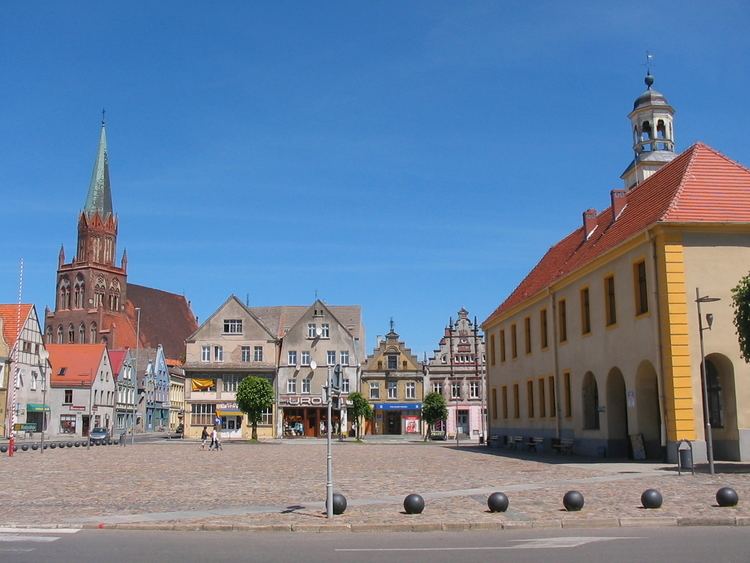City rights 1277 Area 10.14 km² Local time Saturday 11:02 PM | Established 9th century Time zone CET (UTC+1) Population 10,196 (2007) | |
 | ||
Weather 3°C, Wind SW at 5 km/h, 91% Humidity Voivodeship | ||
Trzebiatów [tʂɛˈbjatuf] (German: Treptow an der Rega, [ˈtʁeːptoː]) is a town in the West Pomeranian Voivodeship, Poland. As of June 2007, it has 10,196 inhabitants.
Contents
Map of Trzebiat%C3%B3w, Poland
History
The lower Rega area around Gryfice and Trzebiatów was site of a Slavic gród in the 9th century. The first recorded mention of the town comes from 1170 when the Pomeranian duke Kasimir I granted a few villages and oversight of a church in the town to settlers from Lund in Sweden.
In 1504, Johannes Bugenhagen moved to the town and became Rector of the local school. On December 13, 1534, a diet was assembled in the town, where the Dukes Barnim XI and Philip I as well as the nobility officially introduced Lutheranism to Pomerania, against the vote of Erasmus von Manteuffel, Prince-Bishop of Cammin. In the following month Bugenhagen drafted the new church order (Kirchenordnung), founding the Pomeranian Lutheran church, today's Pomeranian Evangelical Church.
As a dowager, Sophia of Schleswig-Holstein-Sonderburg (1579–1658), widow of Philip II, Duke of Pomerania, lived in Treptow. Sophia's dower was a former nunnery, which she converted into a palace. While in Swedish service and thereafter Duke Francis Henry of Saxe-Lauenburg spent a lot of time with Duchess dowager Sophia in Treptow. Sophia's and Francis Henry's fathers were cousins. On 13 December 1637 Francis Henry and Marie Juliane of Nassau-Siegen (1612–1665) married in Treptow. Their first child was born in Treptow in 1640. Francis Henry also served Sophia as administrator of the estates pertaining to her dower.
When in 1637 with Philip II's death the Pomeranian ducal house was extinct, the duchy was under Swedish occupation with the Brandenburgian electors claiming succession in Pomerania. Not until 1648 the electors prevailed in succeeding as dukes of Pomerania, however, only in the central and eastern part of ducal Pomerania (1653–1815), including Treptow.
In 1750 Treptow Palace was refurbished in classicist style for General Frederick Eugene of Württemberg, who resided there – with interruptions – until 1763. With the end of the Holy Roman Empire in 1806, Brandenburg-Pomerania, already since 1618 ruled in personal union with Ducal Prussia (Kingdom since 1701), also legally merged into Prussia and the different German confederacies and empires, of which it formed part since. In 1945 central and eastern Pomerania, including Treptow, became part of Poland.
Culture
Trzebiatów's Day of the Buckwheat is a celebration during the first week of August. It is a memorial to day when the town guard by mistake dropped a hot bowl of buckwheat meal on invaders from the nearby town of Gryfice, alarming whole town and saving it. Inhabitants of Trzebiatów celebrate that event with dances, concerts, competitions and eating of cereal with ham and bacon.
People
Twinning cities
The sister cities of Trzebiatów are:
